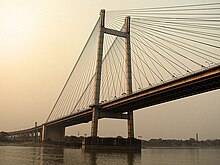Vidyasagar Setu
Vidyasagar Setu (Second Hooghly bridge) | |
|---|---|
 | |
| Coordinates | 22°33′25″N 88°19′40″E / 22.55694°N 88.32778°E |
| Carries | 6 general purpose lanes |
| Crosses | Hooghly River |
| Locale | Calcutta,West Bengal |
| Maintained by | Hooghly River Bridge Commissioners |
| Characteristics | |
| Design | Cable bridge |
| Total length | 823 metres (2,700 ft) |
| Width | 35 metres (115 ft) |
| Longest span | 457.2 metres (1,500 ft) |
| Clearance below | 26 metres (85 ft) |
| History | |
| Opened | 10th October, 1992 |
| Location | |
 | |
Vidyasagar Setu (commonly known as the Second Hooghly Bridge), is a bridge over the Hooghly River in West Bengal, India. It links the city of Howrah to its twin city of Kolkata. The bridge is a toll bridge for all vehicles. It is one of the longest bridges of its type in India and one of the longest in Asia.
The bridge is named after the 19th century Bengali reformist Ishwar Chandra Vidyasagar.

The bridge also has sister bridges over the river at different points, namely the Howrah Bridge (Rabindra Setu) and the Vivekananda Setu.
The Vidyasagar Setu is a cable-stayed bridge, with a main span of a little over 457 metres, and a deck 35 metres wide. Construction started in 1978 and the bridge was finally inaguarated on the 10th of October, 1992. The commissioning agency was the Hooghly River Bridge Commission (HRBC) and the contractors for the construction was the consortium of Braithwaite, Burn and Jessop also called BBJ.

